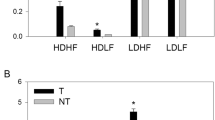Abstract:
Transgenic channel catfish (Ictalurus punctatus) containing salmonid growth hormone genes can grow 33% faster than normal channel catfish under aquaculture conditions. However, before transgenic catfish are released and utilized by the private sector, their genetic impact on the natural environment must be examined. Predator avoidance is one of the major fitness traits determining potential environmental risk. To determine the predator avoidance ability and growth performance of transgenic catfish in a natural habitat, various densities of transgenic and nontransgenic channel catfish were communally stocked in 0.04-ha earthen ponds without supplemental feeding. Largemouth bass (Micropterus salmoides) and green sunfish (Lepomis cyanellus) were stocked as predators. Nontransgenic fry had better predator avoidance than transgenic channel catfish when data were pooled (p < .01). When data were not pooled, nontransgenic catfish had better predator avoidance in six trials and transgenic individuals had better predator avoidance in four trials. There was no difference in predator avoidance in three trials. Overall predator avoidance was also better for nontransgenic individuals (p < .01) when the fish were evaluated as 3.5-g fingerlings, more clearly than as fry, as transgenic individuals were more vulnerable in 3 of 4 trials at this life stage. There was no significant difference in growth performance between transgenic and nontransgenic channel catfish in ponds without supplemental feeding. These findings indicate that transgenic channel catfish could be used for commercial aquaculture without affecting the natural environment. Although transgenic channel catfish may be released to nature by accident, any ecological effect would be unlikely because the increased susceptibility of transgenic channel catfish to predators would most likely decrease or eliminate the transgenic genotype.
Similar content being viewed by others
Author information
Authors and Affiliations
Additional information
Received March 8, 1999; accepted June 3, 1999.
Rights and permissions
About this article
Cite this article
Dunham, R., Chitmanat, C., Nichols, A. et al. Predator Avoidance of Transgenic Channel Catfish Containing Salmonid Growth Hormone Genes. Mar. Biotechnol. 1, 545–551 (1999). https://doi.org/10.1007/PL00011809
Issue Date:
DOI: https://doi.org/10.1007/PL00011809




